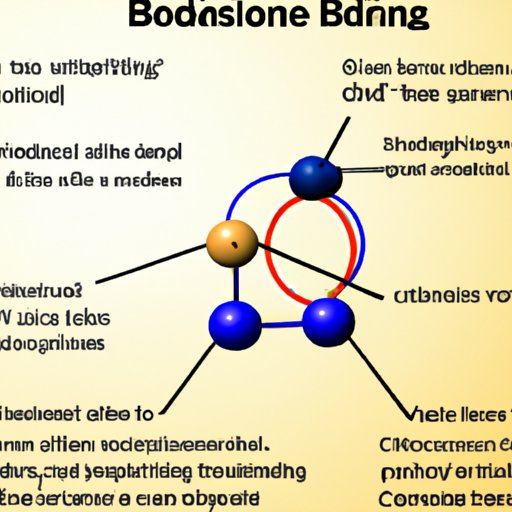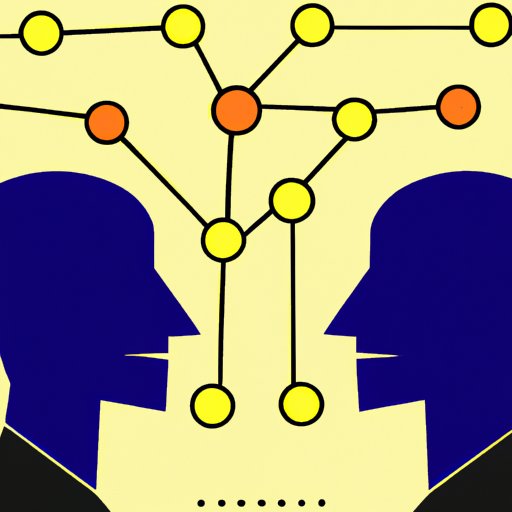Introduction
Bonding is an important part of human relationships. It involves creating an emotional connection with someone else, which can be beneficial for both parties involved. But what exactly does it mean to bond with someone, and how does it work? This article will explore the science and psychology behind bonding in relationships, including examples of different types of bonding, the benefits of bonding, how to create a strong bond with someone, and the impact of technology on bonding.
Definition of Bonding
Bonding is the process of forming an emotional attachment or connection between two people. It involves a deep level of trust and understanding, and it often develops over time as people get to know one another better. Bonding is different from physical attraction, which is more focused on physical appearance. Instead, bonding is based on emotional closeness and shared experiences.

Overview of the Science Behind Bonding
The science behind bonding is complex and involves several factors. On a biological level, hormones like oxytocin are released when people bond with one another. Oxytocin is sometimes referred to as the “love hormone” because it increases feelings of trust, comfort, and attachment. Additionally, the brain releases dopamine, a neurotransmitter that is associated with pleasure and reward. This combination of hormones can create a powerful bond between two people.
Examples of Different Types of Bonding
There are many different types of bonding that can occur in relationships. Here are some of the most common:
Social Bonding
Social bonding involves forming a connection through shared interests and activities. It can involve anything from attending the same school or church to participating in the same hobbies or sports teams. Social bonding is often the first step in developing a deeper emotional bond.
Emotional Bonding
Emotional bonding involves sharing feelings and emotions with one another. It involves communicating openly and honestly about thoughts and feelings, as well as being able to empathize and sympathize with one another. This type of bonding is essential for developing trust and intimacy in relationships.
Physical Bonding
Physical bonding involves engaging in physical activities together such as hugging, kissing, and cuddling. Physical contact has been shown to release oxytocin and dopamine, which can help strengthen the bond between two people. It also helps to increase feelings of safety and trust.
Benefits of Bonding in Relationships
Bonding in relationships can provide numerous benefits, including:
Increased Understanding
When people bond with one another, they are better able to understand each other’s thoughts and feelings. This can lead to more effective communication, which can help to resolve conflicts and disagreements more quickly and effectively.
Strengthened Commitment
Bonding can help to strengthen the commitment between two people, as it creates a sense of loyalty and trust. This can help to ensure that the relationship remains strong, even in difficult times.
Enhanced Intimacy
Bonding can also lead to enhanced intimacy between two people. As people learn more about each other, they can become more comfortable expressing their true selves. This can lead to a more meaningful connection and a greater sense of closeness.

How to Create a Strong Bond with Someone
Creating a strong bond with someone requires effort, but it can be done. Here are some tips for creating a strong bond with someone:
Establish Common Ground
One of the best ways to create a bond with someone is to find something that you both have in common. This could be anything from shared interests to similar values or beliefs. Finding common ground can help to create a stronger connection between two people.
Show Interest and Appreciation
It’s also important to show interest in the other person and to express appreciation for them. This can help to make the other person feel valued and appreciated, which can lead to a stronger bond.
Spend Quality Time Together
Finally, spending quality time together is essential for creating a strong bond with someone. This could involve anything from going on a date to simply spending time at home together. Whatever it is, make sure it’s something that both of you enjoy.

The Importance of Communication in Bonding
In addition to spending time together, it’s also important to communicate openly and honestly with one another. Here are some tips for effective communication in relationships:
Open Dialogue
Engage in open dialogue with one another. Don’t be afraid to share your thoughts and feelings, and be willing to listen to the other person’s perspective without judgment.
Express Feelings and Needs
Be honest about your feelings and needs. Expressing your feelings and needs can help to foster understanding and empathy between two people.
Listen and Validate
Finally, it’s important to listen to the other person and validate their feelings. Listening and validating can help to create a safe environment for communication, which can lead to a stronger bond.
The Impact of Technology on Bonding
Technology has had a major impact on bonding in relationships. Here are some ways that technology can facilitate bonding:
Facilitates Long Distance Connections
Technology makes it easier than ever to stay connected with someone, even if they are far away. Through video calls, text messages, and other forms of digital communication, it’s possible to maintain a strong bond with someone even if they’re not physically present.
Enhances Digital Communication
Technology can also enhance digital communication by making it easier to share photos, videos, and other digital media. This can help to create a stronger bond by allowing people to share more of themselves with one another.
Creates Opportunities for Virtual Interaction
Finally, technology can create opportunities for virtual interaction, such as playing online games together or watching movies together via streaming services. These activities can help to create a strong bond by providing a shared experience.
Psychological Theories of Bonding
Psychologists have developed several theories to explain why people form bonds with one another. Here are some of the most popular theories:
Attachment Theory
Attachment theory suggests that people form bonds with those who they perceive as safe and reliable. This theory states that people seek out secure attachments in order to feel protected and loved.
Social Exchange Theory
Social exchange theory suggests that people form bonds in order to gain something in return. This could be anything from emotional support to tangible rewards such as money or status.
Self-Expansion Model
The self-expansion model suggests that people form bonds in order to expand their sense of self. This could involve experiencing new things or learning more about oneself.
Conclusion
Bonding is an essential part of human relationships. It involves creating an emotional connection with someone else, which can be beneficial for both parties involved. There are many different types of bonding, including social, emotional, and physical bonding. Bonding can provide numerous benefits, including increased understanding, strengthened commitment, and enhanced intimacy. Additionally, technology has had a major impact on bonding in relationships by facilitating long distance connections, enhancing digital communication, and creating opportunities for virtual interaction. Finally, psychologists have developed several theories to explain why people form bonds with one another. Overall, understanding the science and psychology behind bonding can help to create strong and lasting relationships.
(Note: Is this article not meeting your expectations? Do you have knowledge or insights to share? Unlock new opportunities and expand your reach by joining our authors team. Click Registration to join us and share your expertise with our readers.)
